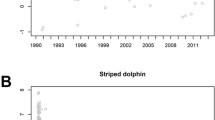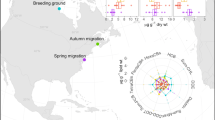Abstract
Blubber from stranded South American sea lions (Otaria flavescens) was sampled between 1991 and 2005 on the Peninsula Valdés in Argentina and analyzed for organochlorine (OC) pollutants. Mean blubber concentrations, expressed on an extractable basis, were 686 (SD = 1,060) ng g−1 for dichlorodiphenyl trichloroethane (tDDT) and 735 (SD = 787) ng g−1 for polychlorinated byphenils (PCB). The OC levels were well below those associated with adverse sublethal effects and lethality in mammals. OC concentrations showed statistically significant associations with age that were positive in males and negative in females. These trends are consistent with the majority of marine mammal populations studied. There were no trends in the levels of tDDT or PCB over time. In spite of the low levels detected, OC contamination was present consistently over the 14-year period, suggesting continuous inputs from geographic redistribution.




Similar content being viewed by others
References
Aguilar A (1984) Relationship of DDE/tDDT in marine mammals to the chronology of DDT input into the ecosystem. Can J Fish Aquat Sci 4:840–844
Aguilar A, Borrell A (1994) Abnormally high polychlorinated biphenyl levels in striped dolphins (Stenella coeruleoalba) affected by the 1990–1992 Mediterranean epizootic. Sci Total Environ 154:237–247
Aguilar A, Borrell A, Reijnders PJH (2002) Geographical and temporal variation in levels of organochlorine contaminants in marine mammals. Mar Environ Res 53:425–452
Blasius ME, Goodmanlow GD (2008) Contaminants still high in top-level carnivores in the Southern California Bight: levels of DDT and PCBs in resident and transient pinnipeds. Mar Poll Bull 56:1973–1982
Borrell A, Aguilar A (1999) A review of organochlorine and metal pollutants in marine mammals from Central and South America. J Cetacean Res Manage 1-195-207 (Sp. Issue 1)
Crespo EA (1988) Dinámica poblacional del lobo marino de un pelo, Otaria flavescens (Shaw, 1800), en el Norte del litoral patagónico. Phd, University of Buenos Aires, Argentina
Dans SL, Crespo EA, Pedraza SN, Koen-Alonso M (2004) Recovery of the South American sea lion (Otaria flavescens) population in northern Patagonia. Can J Fish Aquat Sci 61:1681–1690
Del Toro L, Heckel G, Camacho-Ibar VF, Schramm Y (2006) California sea lions (Zalophus californianus californianus) have lower chlorinated hydrocarbon contents in northern Baja California, Mexico, than in California, USA. Environ Pollut 142:83–92
Fillmann G, Hermanns L, Fileman TW, Readman J (2007) Accumulation patterns of organochlorines in juveniles of Arctocephalus australis found stranded along the coast of Southern Brazil. Environ Pollut 146:262–267
Forsyth DJ (2001) Extrapolation of laboratory tests to field populations. In: Shore RF, Rattner BA (eds) Ecotoxicology of wild mammals. Wiley, London, pp 577–634
Hutchinson JD, Simmonds MP (1994) Organochlorine contamination in pinnipeds. Rev Environ Contam Toxicol 136:123–167
Kajiwara N, Ueno D, Takahashi A, Baba N, Tanabe S (2004) Polybrominated diphenyl ethers and organochlorines in archived northern fur seal samples from the Pacific coast of Japan, 1972–1998. Environ Sci Technol 38:3804–3809
Kannan K, Blankenship AL, Jones PD, Giesy JP (2000) Toxicity reference values for the toxic effects of polychlorinated biphenyls to aquatic mammals. Hum Ecol Risk Assess 6:181–201
Le Boeuf BJ, Giesy JP, Kannan K, Kajiwara N, Tanabe S, Debier C (2002) Organochloride pesticides in California sea lions revisited. BMC Ecol. doi:10.1186/1472-6785-2-11
Lee JS, Tanabe S, Umino H, Tatsukawa R (1996) Persistent organochlorines in Steller sea lion (Eumetopias jubatus) from the bulk of Alaska and the Bering Sea, 1976–1981. Mar Pollut Bull 32:535–544
Loughlin TR, Castellini MA, Ylitalo G (2002) Spatial aspects of organochlorine contamination in northern fur seal tissues. Mar Pollut Bull 44:1024–1034
Menone ML, de Moreno JEA, Moreno VJ, Lanfranchi AL, Metcalfe TL, Metcalfe CD (2001) Organochlorine pesticides and PCBs in a southern Atlantic coastal lagoon watershed, Argentina. Arch Environ Contam Toxicol 40:355–362
Miglioranza KSB, Aizpún de Moreno JE, Moreno VJ (2003) Dynamics of organochlorine pesticides in soils from a Southeastern region of Argentina. Environ Toxicol Chem 22:712–717
Szapkievich VB, Cappozzo HL, Crespo EA, Bernabeu RO, Comas C, Mudry M (1999) Genetic relatedness in two Southern sea lion (Otaria flavescens) rookeries in Southwestern Atlantic. Zeitsch Säugetier 64:1–5
Vetter W, Weichbrodta M, Scholza E, Luckasa B, Oelschlägerb H (1999) Levels of organochlorines (DDT, PCBs, toxaphene, chlordane, dieldrin, and HCHs) in blubber of South African fur seals (Arctocephalus pusillus pusillus) from Cape Cross/Namibia. Mar Pollut Bull 38:830–836
Ylitalo GM, Stein JE, Hom T, Johnson LL, Tilbury KL, Hall AJ, Rowles T, Greig D, Lowenstine LJ, Gulland FMD (2005) The role of organochlorines in cancer-associated mortality in California sea lions (Zalophus californianus). Mar Pollut Bull 50:30–39
Acknowledgments
Thanks are due to many people from the Marine Mammal Laboratory (CENPAT who helped with fieldwork and collected tissue samples for this study). Logistic support for field work was provided by Centro Nacional Patagónico. Lourdes Berdier from Serveis Científico Tècnics of the University of Barcelona is gratefully acknowledged for GC–MS technical support and laboratory assistance. This study was possible through funding granted by Fundación BBVA.
Author information
Authors and Affiliations
Corresponding author
Rights and permissions
About this article
Cite this article
Borrell, A., Garcia-Solà, A., Aguilar, A. et al. Organochlorine Residues in South American Sea Lions, Otaria flavescens (Shaw, 1800): Bioaccumulation and Time Trends. Bull Environ Contam Toxicol 84, 731–737 (2010). https://doi.org/10.1007/s00128-010-0025-x
Received:
Accepted:
Published:
Issue Date:
DOI: https://doi.org/10.1007/s00128-010-0025-x




